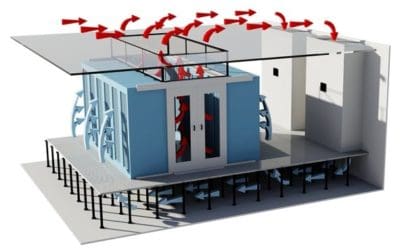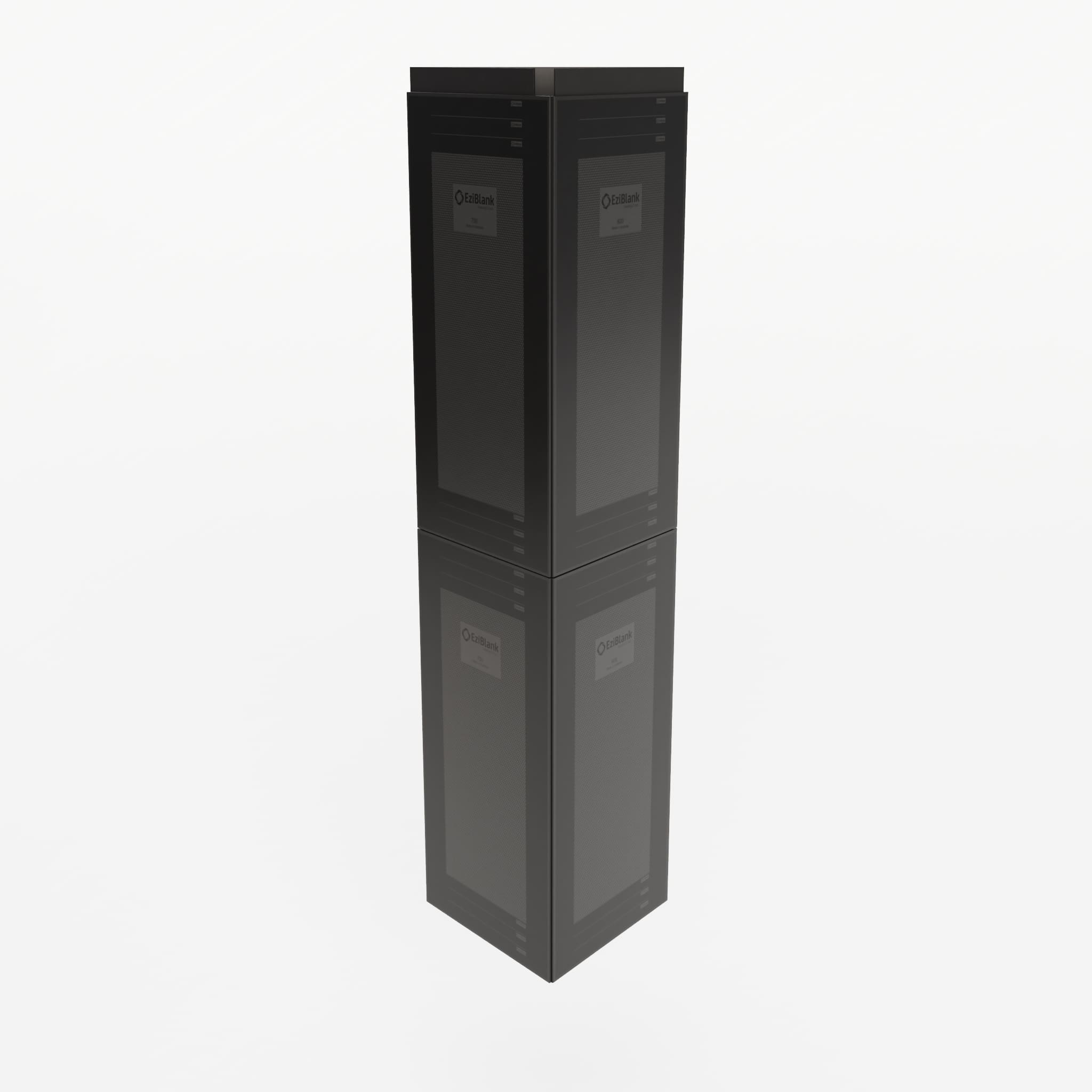Choosing between a server rack and a network rack defines the performance, scalability, and safety of your IT infrastructure. These two rack types serve distinct roles inside data centers and server rooms, and understanding their technical differences helps align your hardware strategy with operational goals.
At Eziblank, we work closely with data center engineers and IT facility managers across industries to develop airflow and containment solutions that match the exact rack configuration, whether it’s high-density server enclosures or shallow-depth network frames. While server racks are engineered to support mission-critical, heat-intensive computing environments, network racks prioritize cable routing, switch management, and patch panel accessibility.
Learn more about how airflow affects server performance in our detailed guide on how airflow works inside a server.
What Is a Server Rack?
A server rack is a robust metal framework designed to mount, secure, and cool servers, storage arrays, and power distribution equipment.
The standard dimension is 19 inches in width, but depth ranges from 900mm to 1200mm, depending on the server length and accessories.
Server rack features include the following:
- Deeper chassis (commonly 1000mm+) to accommodate large enterprise-grade servers
- High weight capacity to hold multiple stacked units, UPS systems, and heavy-duty hardware
- Enhanced cooling through perforated doors, dedicated ducting, and hot/cold aisle integration
- Security enclosures with lockable panels for physical data protection
- Compatibility with airflow accessories, including 1RU brush panels and raised floor grommets
Server racks are vital for maintaining thermal efficiency, particularly in high-density environments. Learn how our blanking panels reduce PUE by eliminating recirculation zones within these enclosures.
What Is a Network Rack?
A network rack is a shallow-depth rack system designed to manage switches, routers, patch panels, and structured cabling equipment. Unlike server racks, network racks do not require high-load support or advanced cooling due to the lighter and cooler nature of the devices they hold.
Key characteristics of a network rack include:
- Shallower depth, typically under 800mm, to support slim networking devices
- Superior cable management with integrated trays, ring supports, and labeling
- Lighter build, allowing wall-mounted or mobile installation options
- Open-frame accessibility for fast connection tracing and hardware replacement
- Less focus on ventilation, though airflow remains essential for uptime
Read our resource on what a patch panel is and why your data center needs it for a closer look at core network components often installed inside network racks.
Major Differences Between Server Racks and Network Racks
The structural, operational, and thermal demands of server racks and network racks are fundamentally different. Here’s a clear breakdown across key performance criteria:
| Feature | Server Rack | Network Rack |
| Primary Use | Servers, UPS systems, storage arrays | Switches, routers, patch panels |
| Depth | 1000mm–1200mm | Under 800mm |
| Weight Capacity | High – supports heavy equipment | Lower – supports lighter devices |
| Cooling Design | Essential – supports airflow accessories | Secondary – airflow is less critical |
| Security | Lockable doors and panels | Often open frame or light enclosure |
| Cable Management | Basic – servers pre-bundled cables | Advanced – structured cabling focus |
| Internal Accessories | Blanking panels, PDUs, brush strips | Patch panels, cable trays, and access doors |
For server rack configurations that require custom airflow, explore our tailor-made solutions for improved cooling and cable pathways.
Server Rack vs Network Rack: Key Differences Explained
Understanding the difference between a server rack and a network rack helps optimize airflow, uptime, and manageability in your IT space. Below is a detailed comparison of critical technical and operational parameters:
Cooling & Airflow Needs
Server racks require advanced passive or active cooling setups. This includes airflow direction control, blanking panels, raised floor grommets, and containment strategies to maintain optimal thermal conditions for high-performance servers.
Our data center cooling best practices explore how airflow planning ensures server performance stability and reduces the risk of thermal shutdowns.
Network racks prioritize open ventilation rather than dedicated cooling infrastructure. Since networking equipment like switches and patch panels generates less heat, airflow in network racks focuses on avoiding cable obstruction rather than temperature control.
Security Features
Server rack enclosures feature high-grade physical security. Lockable doors, tamper-resistant panels, and restricted-access mounting are essential when housing sensitive hardware in regulated sectors like finance or healthcare.
Network racks may have minimal or no locking options. They are built more for convenience and accessibility, especially in office or semi-public environments that require fast network maintenance.
Weight & Load Handling
Server racks are engineered to carry high loads. With reinforced steel frames and heavy-gauge mounting rails, they support servers, UPS systems, and storage arrays, often exceeding 800kg in total weight.
Network racks are lighter in structure. They hold switches, routers, and large volumes of cabling, not mass-intensive equipment. However, they must still offer balanced cable management to avoid strain on connectors and ports.
Cable Management
Network racks prioritize structured cabling design. Cable trays, D-rings, vertical organizers, and labeling slots are integral. For network optimization, visit our guide on patch panels and their role in IT infrastructure.
Server racks offer basic cable pathways. While rear-access trays and horizontal rings are often present, the design focuses more on accommodating server chassis and cooling pathways than cable aesthetics.
When Should You Use a Server Rack?
Use a server rack for high-performance, mission-critical compute loads. Server racks are ideal in environments where:
- Application uptime is non-negotiable (e.g., hospitals, finance)
- High thermal output hardware, like blade servers, requires cooling integration
- Security compliance demands locked enclosures
- Equipment scalability is expected, such as in colocation environments
For cost-effective deployment, explore our detailed colocation cost comparison to evaluate options for server infrastructure hosting.
When Should You Use a Network Rack?
Choose a network rack for accessibility, modularity, and network-layer performance.
Recommended scenarios include:
- Structured cabling systems with patch panels and distribution layers
- Office-level infrastructure managing routers, firewalls, and switches
- Spaces needing quick access for cable rerouting and diagnostics
- IT closets and edge deployments where shallow-depth racks reduce footprint
Network racks are also commonly used in micro data center deployments, where modular access and quick setup are prioritized.
Can You Mix Server and Network Gear in One Rack?
Yes, mixed-use or hybrid rack configurations are possible and often necessary in modern IT environments. A standard practice involves mounting heavy servers at the bottom of the rack for better weight distribution, while light networking gear is placed higher for easier access and maintenance.
Smart layout strategies involve:
- Allocating front and rear cable paths
- Segmenting PDU access from the patch panel cabling
- Using blanking panels to preserve cooling zones
Hybrid rack deployment is common in colocation spaces, where clients manage both compute and networking stacks within the same vertical frame. If planning to deploy hybrid systems, our cloud vs enterprise hosting solutions article outlines which infrastructure is best suited to hybrid hosting strategies.
How to Choose the Right Rack: A Checklist
Choosing between a server rack and a network rack depends on several interlinked infrastructure variables. The critical selection criteria are outlined below:
- Equipment Type: If the infrastructure involves high-density servers, UPS systems, or storage arrays, choose a server rack. If the environment is limited to routers, switches, patch panels, or structured cabling, choose a network rack.
Refer to our server room overview for rack environment planning. - Future Growth & Scalability: Server racks are modular and designed for hardware expansion. Choose models with extra RU (rack units) to accommodate upgrades.
Explore our post on blanking panels and airflow efficiency to understand scalable rack cooling. - Cooling Strategy: Racks must align with your airflow management approach. Server racks support front-to-rear cooling; network racks allow passive ventilation. Our data center cooling best practices can help optimize airflow pathways.
- Security Requirements: If data security and physical access control are priorities, server cabinets offer advanced locking systems. For shared or accessible environments, choose open network racks with minimal obstructions.
- Budget Constraints: Server racks often involve higher capital costs due to reinforced construction and thermal management capabilities. Network racks are more cost-effective for setups that prioritize cable management over compute density.
Server rack selection impacts operational uptime, energy efficiency, and maintenance ease. Refer to our product category for blanking panels to explore airflow accessories that align with both rack types.
Which Rack Is Right for Your Data Center Setup?
The correct rack selection depends on the precise functional requirements of your IT environment. Server racks serve compute-heavy, mission-critical setups with strong cooling and security demands. Network racks support agile, cable-dense environments focused on accessibility and space optimization.
Choosing the right rack improves airflow, minimizes downtime, and prepares your infrastructure for growth. Incorrect rack selection leads to poor cable routing, overheating, and wasted space.
For additional guidance, explore our product range of 6RU modular blanking panels or consult the ultimate guide to blanking panels to design a high-efficiency rack layout.
Common Questions About Server and Network Racks
What is the difference between a server rack and a network rack?
A server rack is designed for high-density equipment like servers and UPS units, offering deeper construction and enhanced cooling. A network rack is built for lighter gear such as switches and patch panels, with a focus on cable management and accessibility.
Can you put network gear in a server rack?
Yes, network gear can be housed in a server rack, provided cable management and ventilation are properly addressed. Mixed-use racks are often used in hybrid IT environments.
Do I need a server rack for a home lab?
A server rack is ideal for home labs running multiple servers or virtualization, especially if cooling and noise management are concerns. Smaller wall-mounted or open-frame racks may suit limited setups.
What is a 42U rack?
A 42U rack is a standard full-height server rack measuring approximately 6 feet tall. “U” (rack unit) is a vertical measurement equal to 1.75 inches. 42U racks can accommodate enterprise-grade deployments.





